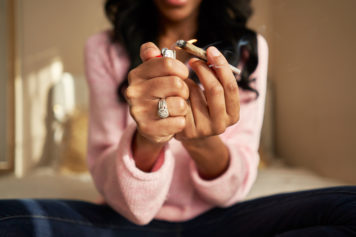
Despite great strides in education and entrepreneurship, a new report finds Black women lag behind other groups in many aspects of American society. (Credit: AP Photo/Nick Ut, File)
Black women voted at higher rates than all other groups of men and women in the past two presidential elections, yet they remain underrepresented at every level of federal and state political office in the United States.
Despite representing about 6.4 percent of the population, only one Black woman, California Sen. Kamala Harris, is a part of the 100-member U.S. Senate. Black women hold less than 4 percent of seats in House of Representatives and state legislatures and only two Black women held a statewide executive elected office as of August 2016.
Those are a few of the many findings in a recently released report titled “The Status of Black Women in the United States” by the Institute for Women’s Policy Research (IWPR), commissioned by the National Domestic Workers Alliance (NDWA), which found Black women face inequality in nearly every facet of American society.
The report draws largely from data from the U.S. Census Bureau.
It's time for us to follow the leadership of Black women #StatusOfBlackWomen https://t.co/Iwjj5sUq5r pic.twitter.com/nPsXgLkMeN
— Alicia Garza (@aliciagarza) June 7, 2017
“This report, “The Status of Black Women in the United States,” is our first attempt to have a holistic view of the conditions that Black American women are experiencing across the country, with an eye toward Black women in the care industry,” Alicia Garza, NDWA’s special projects director and co-founder of Black Lives Matter, said in the report’s forward.
“It is our hope that this research supports on the ground organizing work across the nation and helps form the basis for new policy, practice and legislation that supports the well-being of Black caregivers, so that all caregivers can be cared for in return.”
Here are some other key findings in the report:
More than six in 10 (62.2 percent) Black women are in the workforce. That makes them one of the two racial/ethnic groups of women with the highest labor-force participation rate among women and the only group of women with a higher labor force participation rate than their male counterparts.
Black women’s median annual earnings ($34,000 for full-time, year-round) lag behind most women’s and men’s earnings. Between 2004 and 2014, Black women’s real median annual earnings declined by 5 percent. As of 2014, Black women who worked full time, year round had median annual earnings that were 64.6 percent of White men’s ($53,000).
Black families depend on Black women’s earnings. Eight out of 10 (80.6 percent) Black mothers are the breadwinners of their families, meaning they are either the sole earner or earn at least 40 percent of household income.
While health insurance coverage rates have increased following the 2010 Affordable Care Act, also known as Obamacare, 16.5 percent of non-elderly Black women lacked coverage in 2014. Many of the states that place in the bottom third in the country in terms of Black women’s health insurance coverage are states in which Medicaid expansion has not been adopted since Obamacare.
Between 2004 and 2014, the number of Black women with a bachelor’s degree or higher increased by 23.9 percent, making Black women the group of women with the second-largest educational attainment during the decade. Black women had higher levels of education than Black men (17 percent) but lower levels of education than other groups.
The number of Black women-owned businesses increased by 178 percent between 2002 and 2012, the largest increase among all racial and ethnic groups of women and men. In 2012, Black women owned 15.4 percent of all women-owned businesses. In Georgia, Washington, D.C., and Mississippi, Black women own more than 40 percent of all women-owned businesses. However, businesses owned by Black women had the lowest average sales per firm ($27,753).
Black women experience poverty at higher rates than Black men and women from all other racial/ethnic groups, except Native American women. A quarter of Black women live in poverty (24.6 percent), compared with 18.9 percent of Black men and 10.8 percent of white women, who have the lowest poverty rate among women.
Black women of all ages were twice as likely to be imprisoned as white women in 2014 (109 per 100,000 Black women were imprisoned in state and federal prisons compared with 53 per 100,000 white women). Black women ages 18-19 were four times as likely to be imprisoned as white women of the same age (32 per 100,000 compared with 8 per 100,000).
https://twitter.com/sincerelyash/status/872906387721998339
The report recommends that governments at all levels and other institutions, including those in the private sector, develop policies and practices to increase employment, wages and paid leave, improve access to health care, support affordable childcare, reform the criminal justice system and enforce anti-discrimination laws to reduce the effects of racism and sexism.
“It’s not asking for anything to be ‘given. Black women have done the work, they’ve been active politically and they’re doing all of these things to move not just them forward but their communities and the nation as a whole forward,” Chandra Childers, one of the report’s authors, told Refinery29.com.
“When people say that women of color need to be at the center of policy development, that’s because when you lift women of color — and Black women, in particular — you’re lifting all women.”


